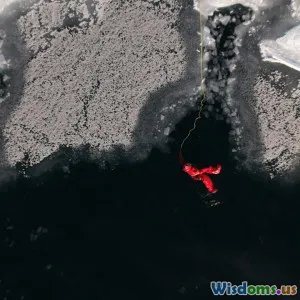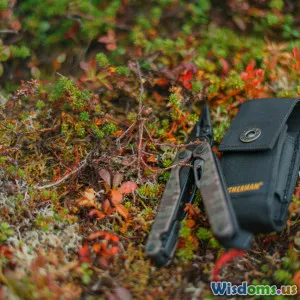
Debunking Five Survival Hacks That Could Get You Hurt
13 min read Discover five widely-shared survival hacks that are dangerously flawed, and learn safer, expert-approved alternatives to keep you unscathed and truly prepared in emergencies. (0 Reviews)
Debunking Five Survival Hacks That Could Get You Hurt
Survival hacks. They bombard us every day: from YouTube demonstrations to TikTok hot-takes, social media, urban legends, and even primetime TV. These quick-fix solutions promise to help us survive in wild, life-threatening emergencies using little more than ingenuity and found items. But what if some of the most popular hacks were not only ineffective—but downright dangerous?
In our hyper-connected age, bad advice spreads as quickly as wildfire. Lives can hang in the balance when misconceptions become 'fact.' Whether you're an outdoor enthusiast, a casual hiker, or someone prepping for the unknown, it's essential to separate myth from reality. Buckle up as we debunk five notorious survival hacks, reveal the real dangers, and arm you with life-saving, evidence-backed alternatives.
Myth 1: Drinking Urine to Stay Hydrated
The Origin of the Hack
This classic scene—a parched adventurer squeezing urine-soaked fabric or drinking directly—has shown up in everything from old explorers' tales to pop-culture icons like Bear Grylls. It's based on the notion that, in the absence of clean water, urine is a 'last resort.'
The Reality—and the Risks
Let’s start with facts: urine is not sterile, and its chemical composition is mostly water, but it contains waste products the body wants to eliminate: salts, urea, ammonia, and toxins.
According to Dr. Jeffrey S. Berns, a nephrology professor at the University of Pennsylvania:
"Drinking urine does not replenish your electrolytes or safely hydrate you. In fact, it accelerates dehydration and increases your risk of kidney damage."
- Medical Dangers: Urine actually draws water out of your body, thanks to the high collection of salts and waste. Drinking it increases your internal solute load, straining your kidneys.
- Contamination Risk: The notion that urine is sterile is inaccurate. After leaving the body, it quickly picks up bacteria from the skin and storage containers, increasing infection risk.
Real-World Example
Professional hikers in the Sonoran Desert tested survival methods on the show 'Lost Survivors.' After going 36 hours without water, John Hudson opted not to drink his urine. Studies performed afterwards found that his body fared better—despite the obvious thirst—because he avoided extra toxin intake.
The Correct Approach
- Collect Water Wisely: Use solar stills, dew collection, or purification of standing water.
- Improvise with caution: If you must drink from questionable sources, filter and boil if possible—nearly all options are better than drinking urine.
- Preserve Sweat, Not Water: Minimize activity during heat, take shelter, and ration effort, not water.
Myth 2: Sucking Venom from a Snake Bite
The Origin of the Hack
Movies and stories often show a heroic companion making a quick incision and sucking venom from someone’s leg or arm after a snakebite. It's depicted as a decisive act of rescue.
What Science Actually Says
The U.S. Centers for Disease Control and Prevention (CDC) and the American Red Cross strongly advise against it.
- Zero Effectiveness: Multiple studies, including a landmark 2002 study published in the Annals of Emergency Medicine, found that traditional first-aid methods—incising the wound and suction—remove less than 2% of injected venom, useless for meaningful treatment.
- New Injuries: Cutting the skin potentially introduces bacteria, increases infection risk, and damages nerves, vessels, and tissue.
- Worse Outcomes: Attempting suction can transfer venom into the person giving aid, potentially poisoning two people.
Real-Life Case Study
A 2017 incident in Arizona involved a 29-year-old bitten by a rattlesnake. Friends attempted suction, worsening tissue necrosis and delaying crucial emergency care. The outcome: severe infection, permanent scarring, and extended recovery.
The Correct Approach
- Immediate 911: Get professional help as soon as possible.
- Keep Still: Immobilize the limb at heart level to slow lymphatic spread of venom.
- No Cutting or Sucking: Leave the wound as is and stay calm—movement and agitation accelerate venom absorption.
Myth 3: Rub Two Sticks Together for Easy Fire
The Romantic Notion
Many survival guides feature the bow-drill, hand-drill, or 'easy' rubbing of two sticks as a quick method for fire.
The Harsh Reality
While it’s not impossible, friction-fire methods are far harder than social media makes them seem.
- Material Challenge: Not all wood is suitable; generally only specific softwoods like willow and cottonwood work, and even these require proper preparation.
- Skill Dependency: Bow-drill fires demand advanced technique, plenty of energy, and dry materials—which are rarely available in emergencies.
According to Les Stroud ('Survivorman'):
“Starting a fire with a bow drill is so difficult that if you haven’t practiced, it can actually cost you valuable time—and life-threatening calories.”
Real-World Data
A 2019 study by the Swedish Survival Society found that over 90% of participants failed to produce fire using friction within two hours, even after guided instruction.
The Real Solution
- Pack Modern Firestarters: Magnesium strikers, stormproof matches, lighters, and compressed cotton can save your life.
- Solar Ignition: A magnifying lens or even angled reflective surfaces can ignite tinder if sun is available.
- Only Attempt as a Last Resort: If you must try friction fire, use the bow drill—not the hand drill—for best effect, and practice beforehand (not for the first time during an emergency).
Myth 4: Eating Raw Plants (or Mushrooms) 'If in Doubt'
The Folklore
Some advice still floats around that “animals eat it, so you can too” or “if a plant is non-bitter and doesn’t burn your lips, it must be safe.”
Biochemistry Says Otherwise
Foraging is science, not guesswork.
- Universal Edibility Test? Flawed: No single test works on all plants. Some, e.g., deadly nightshade, have no taste or warning indicators at fatal dosages.
- Mushrooms are Especially Dangerous: Even veteran foragers have died mistaking deadly amanitas for edible puffballs. The Cleveland Clinic documents that only 1 in 50 wild mushrooms in North America are edible.
- Animal Diets Aren’t Safe Guides: Animals have vastly different digestive systems; reindeer eat mushrooms that are toxic to humans, while deer consume poison hemlock without issue.
Cautionary Tale
In 2013, a hiker in Oregon relied on a wild edibility guide but misidentified blue bead lilies for edible berries. Hours later, severe stomach cramps set in, leading to a week-long hospitalization.
The Safer Course
- Know Specifics: Learn and positively identify a few wild edibles, with expert guidance or certified references.
- Cook When Possible: Heat can break down certain toxins or at least destroy parasites in some plants and fungi.
- When in Doubt, Go Without: Hunger won’t kill you as quickly as the wrong plant might.
Myth 5: Building a “Signal Fire” with Green Branches Anytime Authority is Needed
Smoke, Yes—But Not Just Any Smoke
The idea that adding green branches to a fire will always create highly visible smoke sounds logical and appears in both TV shows and written guides.
The Physics of Signal Fires
- Green = Wet = Smoke: It’s true that wet/fresh vegetation produces smoke, but green can also douse your flames altogether if not carefully managed.
- Timing Matters: A dying flame buried under green foliage may never muster enough heat to generate real smoke.
- Remote Visibility: Without the right mix (steady, strong coals with small amounts of green leafy matter added intermittently), smoke may not be visible for miles as you expect.
According to the U.S. Forest Service:
“Inconsistent fires are the #1 reason wilderness search parties miss or overlook smoke signals. Quality—not quantity—of smoke and fire matters.”
Incident Example
In 2018, an abandoned hiker in Colorado attempted a signal fire with wet pine boughs. Not only did the fire never gain traction, but attempting it exhausted precious kindling the hiker needed to stay warm overnight. The result: a near encounter with hypothermia before rescue teams arrived (who saw neither fire nor smoke).
The Best Approach
- Start Strong: Build as hot, large a core fire as your resources allow first.
- Add Dry for Burn, Then Green for Smoke: Layer in green materials after establishing a hot, stable blaze, and do so in small segments to avoid dousing.
- Three Fires in a Row = Universal Distress Signal: Far better than a single smoldering heap.
- Use Contrasting Materials: Black rubber (if safe), tires, or petroleum-based products can add visibility, but only with care and distance from forests.
Conclusion: Survival Smarts Over Sinister Shortcuts
Our modern hunger for instant solutions and viral content makes it easy for dangerous 'survival hacks' to flourish. Behind every myth are kernels of truth—the urge to hydrate, to treat injuries quickly, to adapt and signal for help. But romanticized shortcuts can create greater hazards than the crisis itself.
As professional mountaineer Ed Viesturs said:
“Getting home safe is the only true goal. Ignore ego, ignore shortcuts—just get home.”
Assess before you act. Always favor knowledge, preparation, and learned skills over luck-driven hacks. Invest time in real wilderness training, carry appropriate gear, and brush up on practical science. When the unexpected strikes, it’s preparation—not a viral video hack—that will keep you safe, alive, and ready to tell the tale.
Further Reading & Resources
- CDC: Snakebite Emergency Care
- National Outdoor Leadership School (NOLS) Wilderness Medicine
- Survivorman: Les Stroud Wilderness Survival Tips
- U.S. Forest Service Fire Information
Whatever your adventure, leave the dangerous myths behind. Trust proven science, expert experiences, and your own well-honed common sense.
Rate the Post
User Reviews
Popular Posts



















